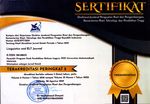A Comparative Study Between Javanese and Madurese Reduplication
Abstract
Keywords
Full Text:
PDFReferences
Marriam Bashir; Muhammad Azeem; Ashiq Hussain Dogar, “Factor Effecting Students ’ English Speaking Skills,” Br. J. Arts Soc. Sci., vol. 2, no. January 2011, pp. 35–50, 2016.
M. D. Habra, M. Ma, D. Samio, M. Pd, A. Nata, and M. Kom, “P e n e r b i t :,” Maj. Ilm. Kultra, vol. 16, no. 1 Juni, pp. 5100–5109, 2015.
S. A. Khashimova, “On the Concept of Reduplication in Linguistics,” Int. J. Curr. Sci. Res. Rev., vol. 05, no. 05, pp. 1659–1664, 2022.
M. D. Kristanti L, I., “REDUPLICATION PATTERNS IN THE UTTERANCE OF MANDURO SOCIETY Ika Lusi Kristanti 1 Diana Mayasari 2 STKIP PGRI Jombang,” JEEL (Journal English Educ. Lit., vol. 05, no. 1, pp. 58–68, 2018.
F. Mustafa, “Evidence of (in)applicability of Morphological Doubling Theory in Acehnese reduplication,” EduLite J. English Educ. Lit. Cult., vol. 7, no. 2, p. 342, 2022.
R. F. Sulistiyani A., Fauza N.A., Rahayu, “Reduplication in Sundanese language : Pupuh Maskumambang,” Proc. Int. Conf., vol. 12, no. 1, pp. 187–193, 2021.
D. M. Ratu and M. G. Maru, “Reduplication of Mongondow Language,” Celt A J. Cult. English Lang. Teach. Lit., vol. 17, no. 2, p. 209, 2017.
D. K. Rachmawati, “Reduplikasi Bahasa Madura Dialek Sumenep dalam Teori Morfologi Distribusional.” p. 217, 2015.
A. C. Alwasilah, Pokoknya Kualitatif. 2009.
A. W. Habibi, “The Comparative Study of Redplication Between English and Indonesian Language,” Edulitics J., vol. 6, no. 1, pp. 1–12, 2021.
J. W. Cresswell, Research design pendekatan kualitatif, kuantitatif dan mixed (terjemahan Achmad Fawaid). 2010.
I. D. P. Wijana, “Reduplication in Javanese,” Linguist. Indones., vol. 39, no. 1, pp. 29–47, 2021.
DOI: https://doi.org/10.31764/leltj.v10i2.12532
Refbacks
- There are currently no refbacks.
Copyright (c) 2022 Linguistics and English Language Teaching Journal

This work is licensed under a Creative Commons Attribution-ShareAlike 4.0 International License.
_____________________________________________________
Linguistics and ELT Journal
p-ISSN 2339-2940 | e-ISSN 2614-8633

LELTJ is licensed under a Creative Commons Attribution-ShareAlike 4.0 International License.
_____________________________________________________
LELTJ is abstracting & indexing in the following databases:
_____________________________________________________
LELTJ Editorial Office:













